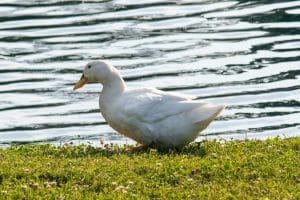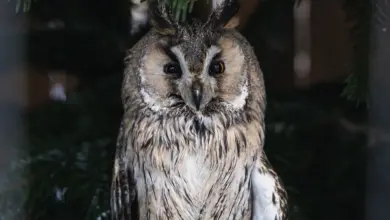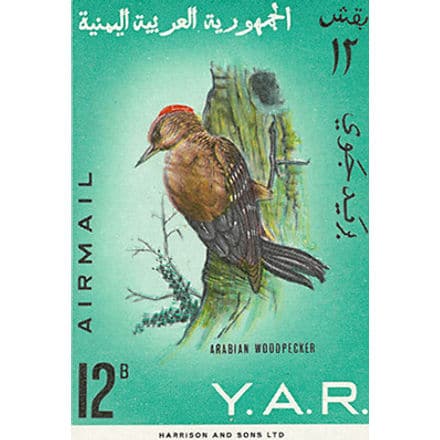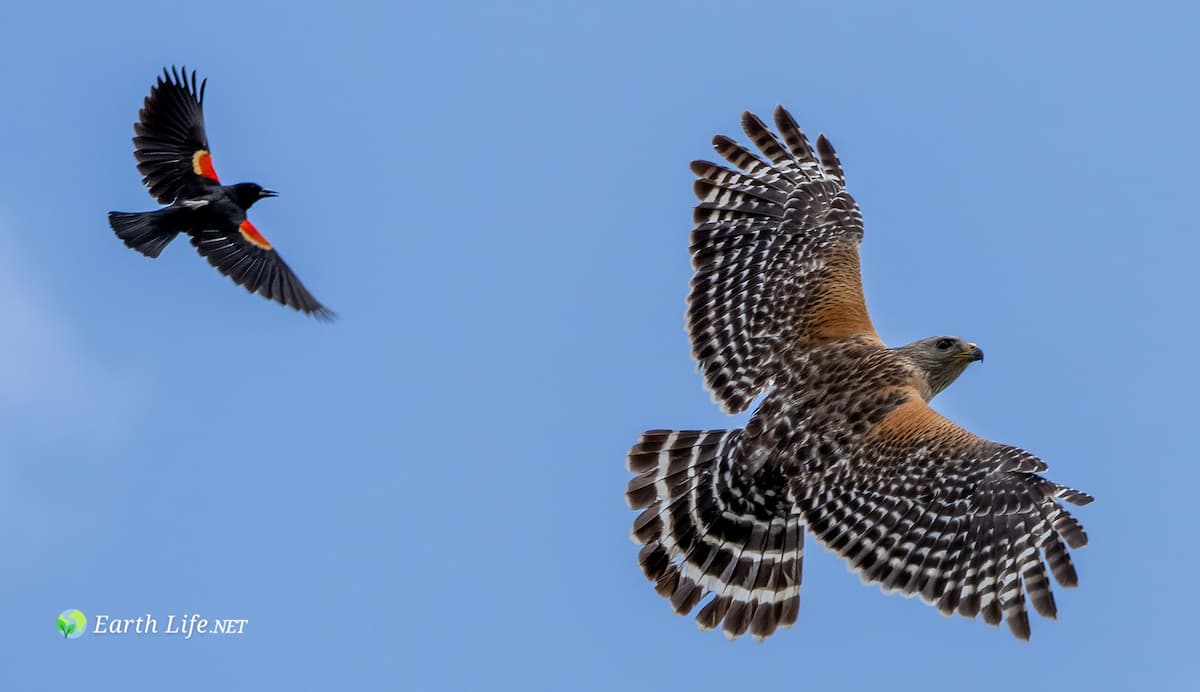Muscovy vs Pekin Duck (& Other Ducks)
Muscovy vs Pekin Duck (& Other Ducks): Differences Explained
If you are confused about which duck to raise on your farm, I will try to explain the key differences between Muscovy vs. Pekin Duck in the article below.
A duck’s a duck, right? Well, wrong.
There are several types of ducks available today, each known for its own unique characteristics.
Some ducks are raised for meat and eggs, others just for show.
Some of fatter and larger, and others are smaller and slender.
Moreover, not all ducks, maybe ducks! For example, many experts agree that the Muscovy duck is more of a goose than a duck.
Confused? Well, that’s what I am here for.
I will explain below the differences between Muscovies and Pekins, the two most popular types of ducks raised on farms.
After that, I will also cover a wide range of other duck types and what each is famous for.
So, let’s get to it, shall we?
Muscovy Duck vs. Pekin Ducks
The most commonly bred ducks for meat and eggs are Pekins and muscovies, so let’s compare them first on various parameters.
What They Look Like
Adult Pekin ducks have glossy white feathers and yellow bills.
Males typically have longer bodies and necks compared to females.
The legs of these ducks may be either orange-yellow or reddish in color.
Pekin ducks have shorter wings and a vertical posture.
Up close, their eyes appear to be grayish-hued, while from a distance, they look black.
Muscovy ducks are large, heavy birds.
The most distinguishing characteristic is the large red warts on their faces, known as caruncles.
They show much variation in their plumage due to differing habitats.
Generally, they have dark feathers, though they come in many colors, including blue, chocolate, pied, and so on.
Adults have white spots on the wings, with juveniles showing smaller marks on theirs.
Muscovy ducks have long necks similar to those of geese.
They have a slightly elongated bill that slopes up to the forehead.
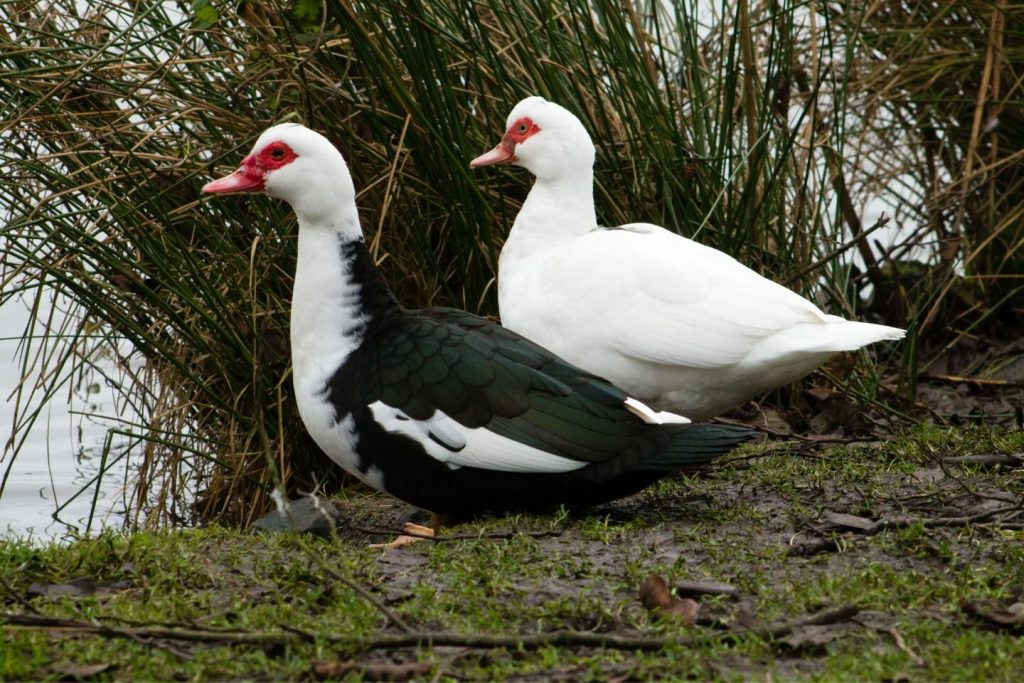
How Big Are They?
Pekin ducks have large, solid, rectangular bodies.
On average, drakes weigh between 10 and 12 pounds, while hens can weigh between 8 and 11 pounds.
Drakes are usually 20 inches long from crown to tail tip, while hens are about 15 inches long.
Muscovy ducks resemble geese, as mentioned earlier.
Their drakes are heavier than those of Pekin ducks, weighing between 10 and 15 pounds.
Hens usually range from 9 to 12 pounds and are much lighter than drakes.
Drakes generally reach 35 inches in length from tail tips to crowns, whereas hens are about 25 inches long on average.
Nature & Aggression
Muscovy ducks are generally peaceful but may become aggressive if provoked.
The males display aggressive behavior when faced with a predator or intruder.
They also engage in territorial fights and try to dominate the other suitors available to potential mates.
Pekins are generally docile and friendly, developing strong bonds with their owners and others in the flock.
Drakes may occasionally be aggressive, but they are easier to handle than hens.
Overall, Pekin ducks can make good pets for bird lovers.
Noisiness
Muscovies are often known as the “quiet” ducks.
They are the quietest option if you live in an area where keeping the noise down is a priority.
Their hisses from males and soft quacks from females are only audible within 10 meters.
Pekins, on the other hand, is much louder.
Female Pekins are very noisy when they feel threatened or hungry.
However, during the day, when content and fed, they typically remain silent.
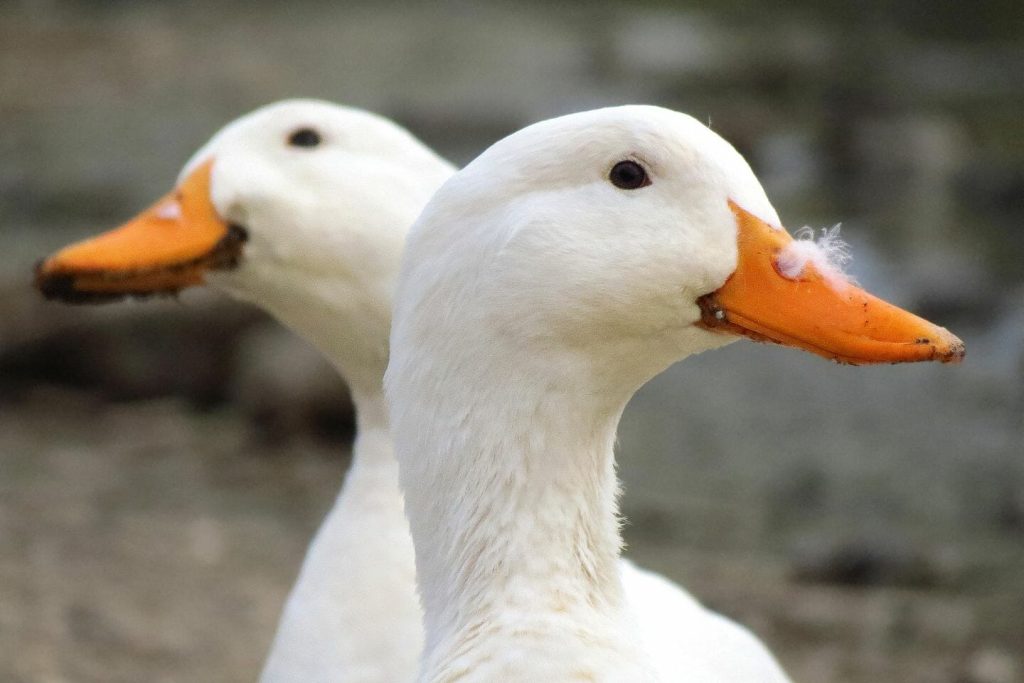
Eggs
Pekin ducks are better egg layers – they can offer as many as 200-300 eggs a year.
While the best egg layers are Khaki Campbells, which can give as many as 350 eggs a year, Pekins are much better than Muscovies.
Muscovy mothers tend to become broody.
They lay in clutches of about 10-22 eggs about four times a year.
But each time, they will then want to set instead of laying more. It becomes hard to get a muscovy not to set.
In terms of quality, muscovy duck eggs are creamier and have higher yolk content.
They are also larger in size.
Meat
Though muscovies tend to get bigger as adults, they take more time to grow.
By the seventh week, a Pekin can easily reach about 2 pounds. Muscovies, on the other hand, need at least ten weeks to reach that stage.
Compared to the White Pekin, the Muscovy duck is higher in fat and tougher due to its older age at the time of harvest.
Muscovy ducks have a stronger flavor than the White Pekin, and their breast or liver is popular for foie gras.
Pekin duck is widely eaten for its mild flavor that can be incorporated into various cuisines.
Its light-colored flesh and subtle taste surpasses either Muscovy or Mulard duck for the whole roasting.
Skinless Pekin duck breast contains fewer fat and calories than skinless chicken breast.
Care
Pekin ducks require a safe, clean, and spacious living environment with 1.5 sq. meters of space per duck.
Provide them shelter during harsh weather and ensure they are protected from predators.
Supplement their diet with protein and vitamins and provide plenty of clean water to drink and bathe in.
Muscovy ducks also need proper housing and a good diet high in protein and calcium.
They require plenty of water for digestion and to keep cool in hot weather.
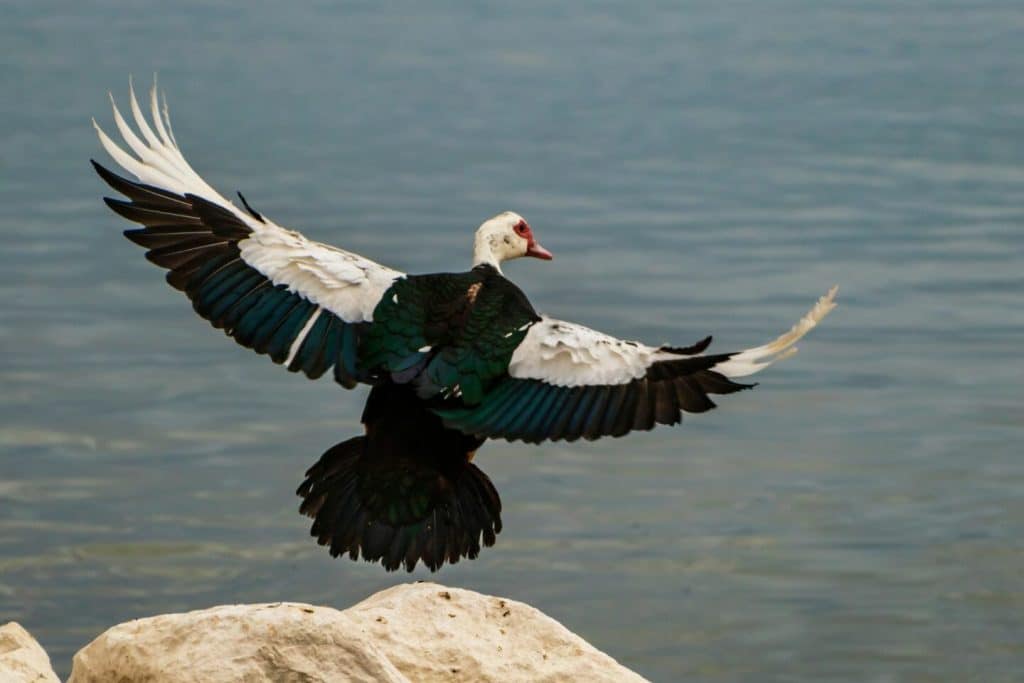
Ability to Fly Away
Female ducks are typically capable of flying higher, while male muscovies are too large and heavy.
These ducks often like to roost instead of nesting on the ground.
While you can clip their feathers to stop them from flying away, muscovies have sharp claws, so it is a bit tricky.
Pekin ducks can’t fly – their wings are not strong enough.
Pest Control
Muscovy ducks can eat anything they can catch, such as houseflies, mosquitoes, and ticks.
Pekins are more selective in their diet, though they still eat more than muscovies.
If allowed to free range, both breeds will forage themselves rather than take feed.
Muscovies also consume more grass than other duck breeds.
Can Muscovy Ducks Breed With Pekin Ducks?
Yes, Muscovies and Pekins can mate.
Unfortunately, the fertility rate in such matings is quite low.
To enhance the rate, breeders often use artificial insemination.
The produced breed is also sterile and good only for duck meat production.
When a male Muscovy is bred with a female Pekin, the offspring is called a Moulard.
Generally, when male Muscovies mate, the hybrid produced is called a mule, but when females mate with a male of another species, it is called a hinny.
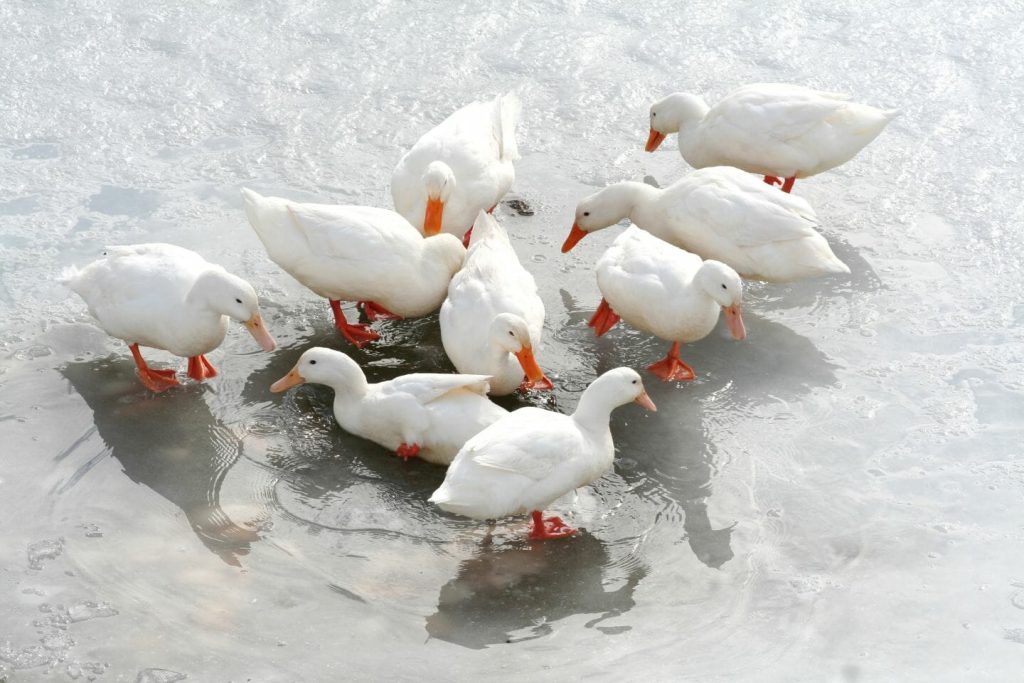
Mallard vs. Muscovy Duck
Next, let us get to the Mallard – the species that has spawned the most variety of ducks (except for the muscovies).
Are Mallards and Muscovies the Same Species?
Mallards and Muscovies are both part of the Anatidae family.
This includes most waterfowl, including ducks, geese, swans, etc.
However, these two birds are from completely different genuses and species.
Muscovies (Cairina moschata) and Mallards (Anas platyrhynchos) also happen to have different origins.
Muscovies are thought to have originated in South America, whereas Mallards originated in Europe, Asia, and most of North America.
Most domesticated duck species that we see today are derived from wild Mallards. The only exception is the Muscovies.
Here are a few differences that set these species apart:
Behavioral Differences
Mallards prefer the water, where they are found most of the time.
Muscovies, on the other hand, are actually more land-dwelling.
They make their nests in tree cavities and roost on tree branches.
Mallards sleep on the ground instead.
Moreover, much of Muscovy’s food comes from foraging for insects on the ground.
Mallards prefer to eat small aquatic insects and plants instead.
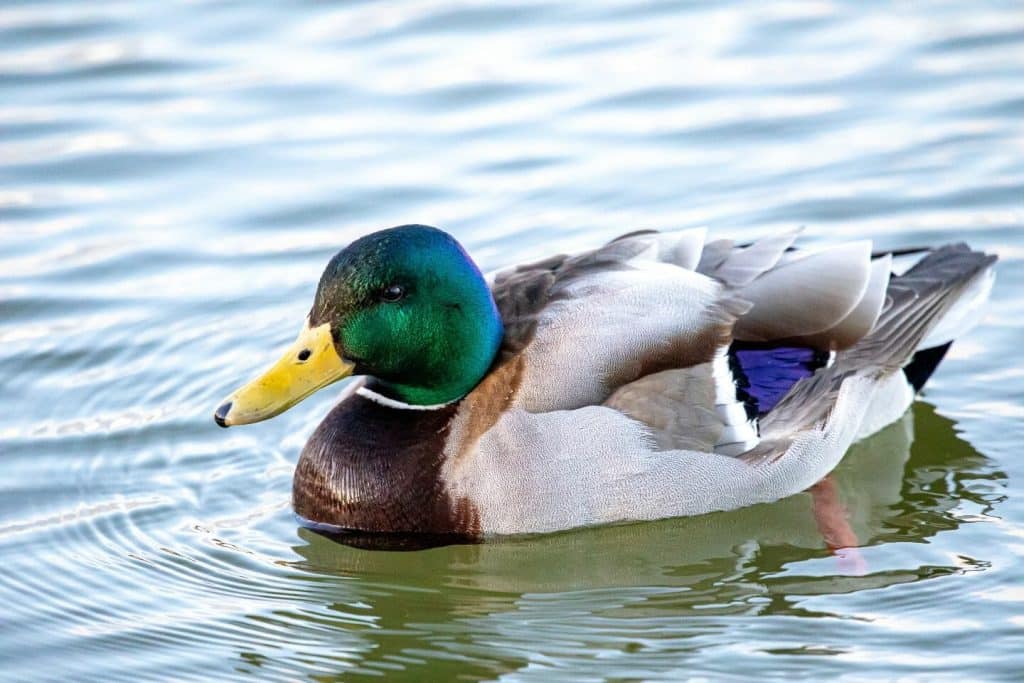
Noise
As mentioned earlier, muscovy ducks are very quiet.
The males make a geese-like hissing sound, whereas the females make soft quacks.
Mallards can create quite a racket. They love to quack a lot, especially when together in a flock.
Apart from these differences, many points that I covered earlier for Pekin ducks apply to Mallards as well.
How to Tell the Difference Between Mallards, Muscovy, and Wood Ducks?
As adults, it is fairly easy to spot the three types of ducks.
Muscovies have their characteristic caruncles, whereas the wood duck has a smorgasbord of colors on its body.
But these birds are hard to differentiate as chicks, which is what I will focus on here.
There’s a brilliant description on the Muscovy Sanctuary of Florida’s website, which I am producing here:
- Mallard: the marking on their head goes from the head to the eye, but not further
- Muscovy: marking ends up from the head to the bill, covering the eye in between
- Wood duckling: marking is heavier and looks more like a Muscovy’s, but does not go to the bill.
Other Duck Breeds
Moulard/Magret Duck vs Muscovy Duck
Moulards are a cross between Muscovys and White Pekins. These birds are born when a male Muscovy mates with a female Pekin.
They are particularly popular for their liver, which is very commonly used for foie gras.
Moulards are rich in fat, and their meat is harder and chewier than that of the Pekins.
Khaki Campbell
Khaki Campbells are a type of Mallard. They are raised specifically for their egg-laying capacity, as mentioned earlier.
These birds can lay as many as 300-400 eggs a year and are excellent poultry birds.
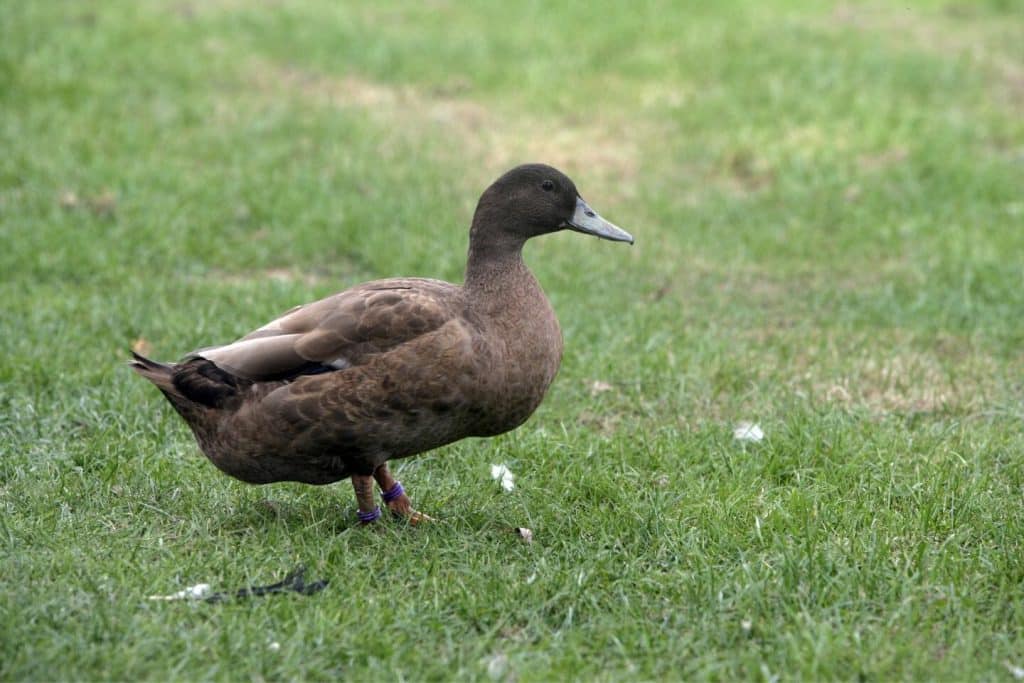
Rohan vs. Muscovy Duck
Rohan ducks are a very specific breed of several ducks, including the Pekin and Heritage Mallards.
These birds have been bred specifically for their tender and juicy meat and a mild taste.
Muscovy Duck vs Rouen
Rouens are native to France. They are also Mallard-derived ducks but are larger in size.
They are thought to have originated from Central and South America, including Mexico.
Cayugas vs. Muscovies
Cayugas are colorful birds with iridescent shades on their plumage. They are mainly from New England and are calm and composed birds.
Cayugas are large birds, though not as big as the Muscovies. These birds can weigh upto eight pounds when fully grown.
They produce excellent meat and are good egg layers as well.
Cayugas used to be a popular game bird earlier but are near extinction today. These birds are no longer raised for commercial meat production anymore.
Runner Ducks vs. Muscovies
Like the Khaki Campbell, Indian Runners are prodigious egg producers. They can lay upto 300 eggs a year.
These birds are thin and long and always have an upright stance.
Are Magpie Ducks Muscovy Ducks?
No, Magpies are a domestic duck breed from Britain.
These birds are often raised for show purposes, though sometimes they might be raised for meat and eggs as well.
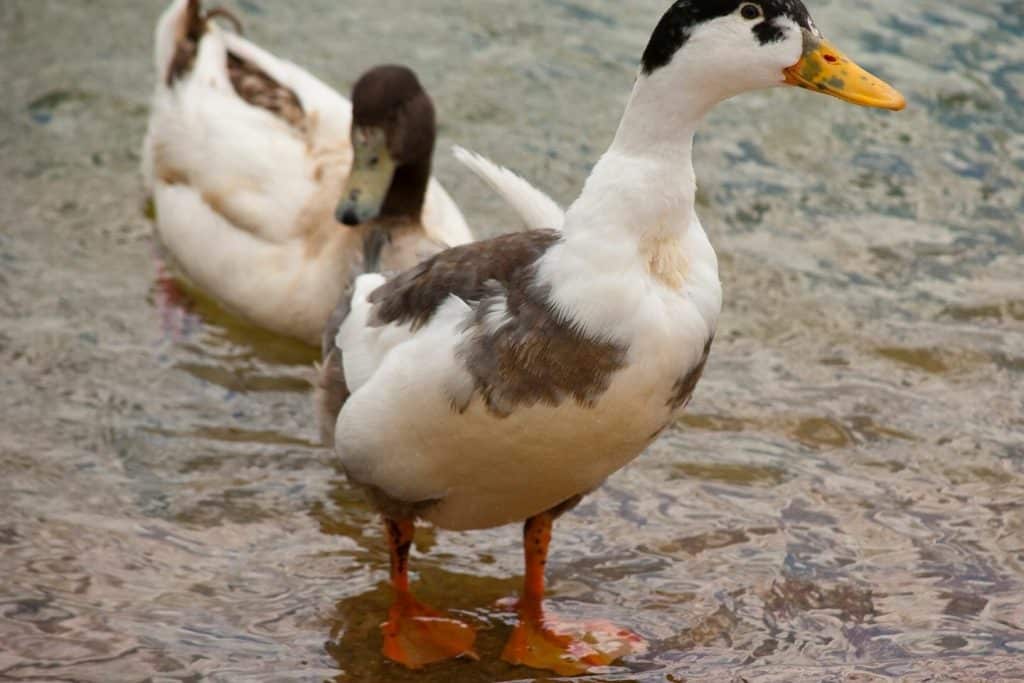
Frequently Asked Questions
Which meat is better, Pekin or Muscovy?
Pekin ducks typically have a milder flavor that is suitable for most dishes. Its meat tends to be more tender and juicy, making it great for roasting or barbecuing.
Muscovy ducks tend to have richer and gamier meat that is ideal for sauces and slow-cooking dishes like stews or casseroles.
In the end, it’s about your personal preference, so you should try different types of ducks until you find the one you like best.
What duck tastes better, Muscovy and Pekin?
Muscovy duck typically has a much richer, fuller flavor than Pekin due to its higher fat content.
Its meat is dark and succulent with a distinctive gamey taste.
Additionally, it is often noted to have notes of chestnuts due to their higher levels of unsaturated fats.
Pekin duck, on the other hand, tends to be milder and sweeter, with less intense flavor and lighter-colored meat.
Why is a Muscovy not a duck?
They are much larger than normal duck breeds and do not possess many of the same traits as ducks.
The plumage is also quite different, with black, white, and grey feathers across their body instead of the typical mallard color pattern.
Furthermore, Muscovies have small seasonal crests on top of their heads which normal ducks lack.
Finally, the males possess red facial caruncles around their eyes that distinguish them from other ducks.
What are the disadvantages of Muscovy ducks?
They have been known to beg for food and drop a lot of feces, which creates a big mess and disturbs people living in the area.
In addition, the males can become aggressive toward each other during mating season.
They also tend not to get along very well with other birds and compete with them for resources.
Wrap Up
So finally, we come to the end of our long list of comparisons.
Overall, muscovies are very different from the rest of the ducks, primarily because they are a whole different species from themselves.
Muscovies love to roost on tree branches, make their nests inside trees, spend most of their time on land, and are very quiet birds.
Other ducks are more water-oriented and typically nest on the ground.
Moreover, muscovies are bigger but grow more slowly and lay fewer eggs.
I hope this guide has helped resolve some of the questions that you had about which duck to get for your farm.
Thank you for reading!

